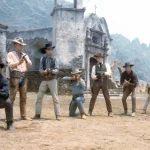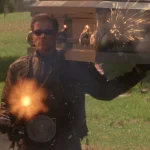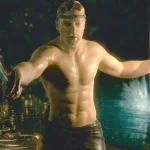🎬 Burial Ground (1981)

Introduction and Plot Overview
Directed by Andrea Bianchi and released in 1981, Burial Ground is a gritty, gory entry in the golden age of Italian horror, riding the wave of zombie fever sparked by George A. Romero’s Dawn of the Dead (1978). Produced on a shoestring budget, this unabashedly bizarre film trades Romero’s social commentary for visceral thrills and surreal weirdness, earning a devoted cult following despite—or perhaps because of—its flaws. Set in a remote Italian villa, it pits a group of ill-fated vacationers against a horde of slow-moving, tool-wielding undead unleashed by a reckless professor’s meddling.
The plot is gloriously thin: Professor Ayres (Raimondo Barbieri), an archaeologist, unwittingly awakens zombies from an ancient Etruscan burial site by tinkering with cryptic artifacts. As he’s devoured, three couples—George (Roberto Caporali), Evelyn (Mariangela Giordano), and Mark (Gianluigi Chirizzi), along with their partners Janet (Anna Valente), Leslie (Simone Mattioli), and James (Claudio Zucchet)—arrive at the villa for a weekend getaway with Evelyn’s oddball son, Michael (Peter Bark). The undead soon besiege them, leading to a night of carnage marked by bizarre deaths, questionable decisions, and a famously unsettling mother-son dynamic. It’s a lean 85 minutes of chaos, prioritizing atmosphere and shock over coherence.
This opening frames Burial Ground as a quintessential Euro-horror artifact—raw, unpolished, and unapologetic. Does it stand as a hidden gem or a glorious mess? Let’s dig into its grisly details.
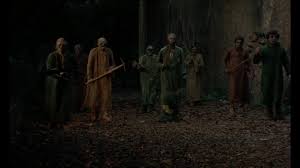
Characters and Performances
The characters in Burial Ground are less people than zombie fodder, defined by broad strokes and dubbed dialogue typical of Italian exploitation cinema. Mariangela Giordano’s Evelyn steals focus as the most memorable survivor, her shrill screams and maternal panic driving the film’s strangest subplot—her son Michael’s creepy fixation on her, culminating in a notorious breastfeeding scene that’s equal parts shocking and absurd. Giordano leans into the melodrama with gusto, though the English dubbing flattens her efforts into camp.
Peter Bark, a 25-year-old dwarf playing the preteen Michael, is the film’s wild card. His eerie stares and stilted line delivery (“Mama, I’m hungry!”) make him a horror oddity—unsettling yet unintentionally hilarious. The rest of the cast—Roberto Caporali’s stoic George, Gianluigi Chirizzi’s bland Mark, and their interchangeable partners—exist to run, scream, and die. Their performances are wooden, hampered by a script that offers little beyond “look scared” or “get eaten.” The lone maid and butler (briefly seen before their demise) add to the body count without fanfare.
The zombies themselves, with their decayed faces and monk-like robes, are the true stars, their slow menace enhanced by practical effects rather than acting. The human characters’ lack of depth keeps Burial Ground from emotional resonance, but their cartoonish panic fuels its schlocky appeal.
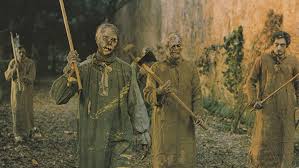
Technical Aspects and Visual Execution
On a technical level, Burial Ground is a testament to low-budget ingenuity. Cinematographer Gianfranco Maioletti bathes the villa and its foggy grounds in a moody, claustrophobic haze, using natural light and shadows to mask the sparse production values. The single-location setting—a real countryside estate—lends authenticity, its crumbling walls and overgrown gardens mirroring the decay of the undead. The score, credited to Elsio Mancuso and Berto Pisano (with uncredited synths possibly by Goblin’s Claudio Simonetti), pulses with eerie drones and funky beats, amplifying the film’s otherworldly vibe.
The gore effects, by Gino De Rossi, are the standout—intestines spill, heads are bashed, and a nipple is bitten off with gleeful abandon. The zombies’ makeup—rotted flesh, milky eyes, and skeletal hands—holds up despite the budget, their deliberate pace adding tension to cramped siege scenes. Tools like scythes and pitchforks give them a unique menace, though their sluggishness borders on comical when characters fail to outrun them. Editing is choppy, with abrupt cuts and pacing that drags in the middle, while the dubbed audio—rife with awkward pauses—adds to the disjointed feel.
Visually, it’s rough-hewn but effective, a snapshot of 1980s Italian horror’s DIY ethos. Its flaws—shaky continuity, cheap props—are part of its charm, making it a time capsule of grindhouse excess.

Themes, Legacy, and Final Verdict
Thematically, Burial Ground is a skeleton of ideas, lacking the subtext of Romero’s work. It flirts with notions of ancient curses and human folly (Professor Ayres’s hubris), but these are mere excuses for carnage. The Michael-Evelyn subplot hints at taboo unease, though it’s more exploitative than insightful. At its core, it’s about survival—or the hilarious lack thereof—as characters make baffling choices (hiding in a room full of windows, anyone?). It’s less a meditation on life and death than a gleeful descent into absurdity.
Its legacy lies in its cult status. Never a box office hit, Burial Ground found life on VHS and, later, Blu-ray, embraced by horror fans for its oddities—Michael’s creepiness, the zombies’ ingenuity, and that ending where the undead overrun the villa as a misspelled “profecy” looms. Critics dismissed it (no Rotten Tomatoes score exists, but disdain was universal), yet its influence echoes in modern B-movie homages. Compared to Fulci’s Zombie or Argento’s stylish gore, it’s cruder but no less memorable.
Ultimately, Burial Ground (1981) is a glorious mess—cheap, bizarre, and unhinged. It’s not for the faint-hearted or those seeking polish, but for lovers of schlock, it’s a treasure trove of grisly delights. Its quirks outweigh its shortcomings, making it a must-see for zombie completists. Final verdict: a shambling, shameless classic that’s as rotten as it is irresistible.



